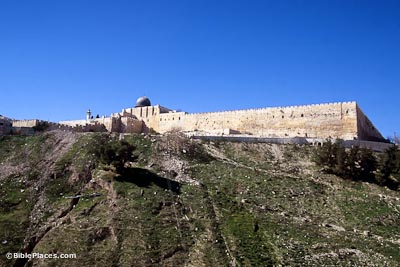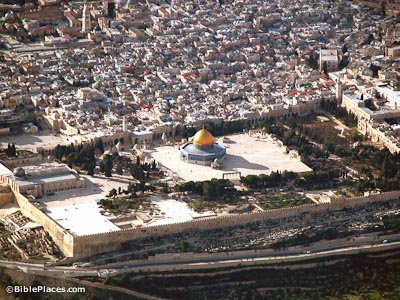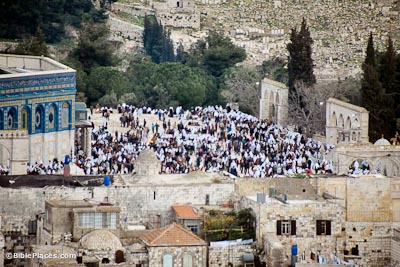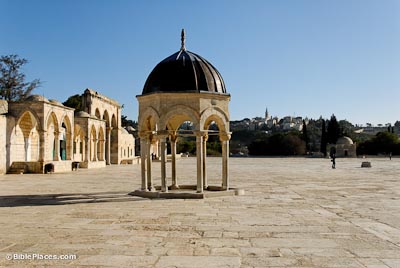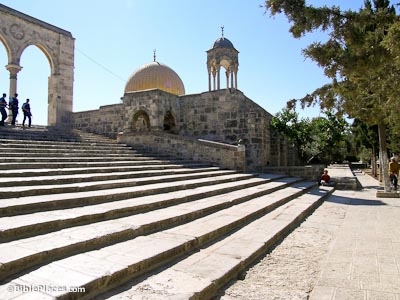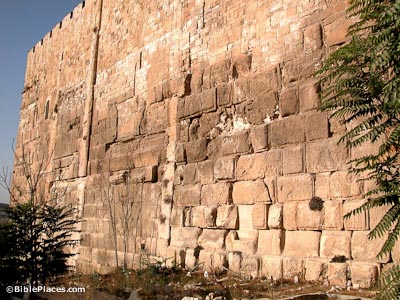Often visitors wonder why the Temple Mount is not the highest point in the city when the Bible seems to describe it as such. The answer is that the city today (including the “Old City”) has grown and shifted from its original location. The earliest city of Jerusalem is the “City of David,” a smaller hill south of, and lower than, the Temple Mount.
Temple Mount
Aerial from East
The present Temple Mount was constructed by Herod the Great beginning in 20 BC. Construction on it continued for 83 years until AD 64 when a halt was called and 18,000 workers were laid off (riots resulted). The Temple Mount is 1/6 the size of today’s Old City and covers 35 acres (14 ha). Construction of this rectangular platform required filling in a large part of the Central Valley.
Crowds at Ramadan
Herod enlarged the existing Temple Mount in order to accommodate the larger crowds of Jewish pilgrims coming for the feasts. Today Muslims in Israel celebrate Ramadan by coming to what they call Haram esh-Sharif (the Noble Sanctuary). More than 400,000 Muslims often gather here on the final Friday of the feast. See Dome of the Rock.
Dome of the Tablets
Because of Muslim control of the Temple Mount, archaeologists are prevented from working on the site. Consequently, scholars lack evidence for determining the precise location of the first and second Temples. Asher Kaufman has theorized that the Holy of Holies originally was located not under the Dome of the Rock but under the Dome of the Tablets (aka Dome of the Spirits).
A Telltale Step
Leen Ritmeyer identified a large step at the bottom of one of the staircases which he believes is the top of the west wall of the pre-Herodian Temple Mount. This step is exactly 500 cubits from the eastern wall of the Temple Mount, matching the Mishnaic measurement of the (apparently earlier) Temple Mount. After this interpretation of this step, authorities laid new pavement to cover the wall.
The Seam
On the southeastern side of the Temple Mount is a “seam” of stones where a later addition leans up against the earlier east wall. There is some debate about the date of this earlier wall (the later is clearly Herodian), but Ritmeyer has convincingly demonstrated that the earlier wall forms the corner of the 500 cubit square Temple Mount. If this identification of the earlier Temple Mount is correct, the Temple must have been located where the Dome of the Rock now sits.

Download all of our Jerusalem photos!
$39.00 $49.99 FREE SHIPPING
Related Websites
Related BiblePlaces.com pages: Dome of the Rock and Southern Temple Mount. For historical images of the site, see Life in the Holy Land. The Bible chapters related to the Temple Mount are many, including Matthew 21, Mark 13, Luke 4, and John 2.
The Temple Mount in Jerusalem (Ritmeyer Archaeological Design) The site of the expert on the subject, featuring descriptions of his slides sets, teaching aids, and other materials. You can view all his posts tagged with “Temple Mount,” or peruse these particularly relevant articles: Flooring from the Temple Mount in Jerusalem (2016) and A Capital from Solomon’s Porch on the Temple Mount (2017).
For further study, we recommend the following books by Leen and Kathleen Ritmeyer.
- The Quest (progresses around Temple Mount, full of information about the walls, reservoirs/cisterns, and history; an excellent volume for research and study)
- Jerusalem—The Temple Mount (focuses more on modern sites, what you will see if you tour Temple Mount today, and what to look for; an excellent book to carry with you on a tour)
The Temple Mount (Jewish Virtual Library) Retells the Jewish and later the Muslim history of the site, including links to descriptions of related terms.
The Temple Mount (See the Holy Land) A few photos, both old and new, along with several models help to illustrate the introductory information contained in this article. Includes discussions about the first and second Temples.
Temple Mount Sifting Project (official site) Run by those who are dedicated to finding archaeological artifacts that would otherwise never see the light, this is a fascinating look at the project begun by Gabriel Barkay.
The Temple Institute (official site) Features links to many research resources. The long term goal of this organization is “to do as much as possible to bring about the rebuilding of the Holy Temple in our time.”
A Short Chronology of Jerusalem and the Temple Mount (personal page, Lambert Dolphin) Brings together history from all ages, in timeline form, for a complete record of the Temple Mount. Reflects some political bias.
The Temple Mount in Jerusalem (templemount.org) Presents three theories on the location of the Jewish temple, highlighting the research of Tuvia Sagiv.
New Evidence for the Site of the Temple in Jerusalem (Associates for Scripture Knowledge) An extensive presentation of an alternate location for the Temple Mount, as proposed by Ernest Martin. See also a response to Ritmeyer’s critique by Martin.
What is Beneath the Temple Mount? (Smithsonian Mag) A fascinating article about some of the work done by the Temple Mount Sifting Project, and what makes it necessary.
The Temple Mount in Jerusalem (The Jewish Magazine) A lengthy article from 2001 about the illegal construction projects taking place on the Temple Mount. Interviews with several key personalities lend a well-rounded perspective to the issue.
The Jerusalem Archaeological Park (All About Jerusalem) This website gives basic visiting information for the archaeological park, accompanied by a few pictures.
The Noble Sanctuary (noblesanctuary.com) A well-done site from a Muslim perspective that doesn’t deny the existence of the earlier Jewish temples.
